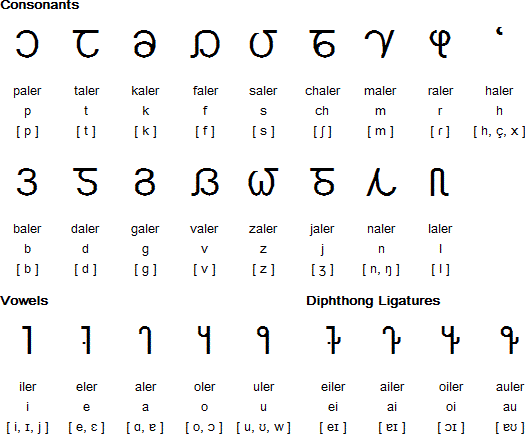Chiasel

The Chiasel script was invented by Matt Youens for use in a fantasy story he is writing. It is used to write the language La Bangu, which has its phonology and vocabulary heavily based on Lojban, and could therefore also be adapted to write Lojban and Loglan.
The name Chiasel comes from the Lojban ‘se ciska’, meaning ‘is written’, and the name of each character is made by attaching it to a shortened form of ‘lerfu’, which means ‘letter’.
The script was not inspired by any particular alphabet, though many of the glyphs have similarities to their counterparts in other writing systems and the cursive forms are reminiscent of Indic and other Asian characters.
Notable features
- Type of writing system: alphabet
- Direction of writing: left to write in horizontal lines
- Used to write: La Bangu
Chiasel alphabet

Pronunciation
- Naler = [ŋ] before kaler or galer, [n] elsewhere.
- Haler = [ç] between a front vowel and a consonant, [x] between a back vowel and a consonant, [h] elsewhere.
- Stressed vowels are tense, unstressed vowels are lax.
- Iler = [j] before another vowel.
- Uler = [w] before another vowel.
Notes
- There is very little punctuation, but // indicates the beginning of a paragraph and the end of a sentence while / marks a pause (effectively a comma or bracket).
- Where there are voiced and voiceless pairs of consonants, the unvoiced character has a single curve while the voiced character has a corresponding double curve; the majority of the characters are derived from these two basic shapes.
- Although they are phonetically fricatives, chaler and jaler graphically fit into the plosive series in reference to their sounds’ origin as soft variants of k and g in many languages.
- Being unique among the consonants in having no voiced equivalent, haler’s form is also unique within the alphabet and is influenced by the Lojbanic use of the apostrophe; it is written where ‘ and x would be used in Lojban as La Bangu treats both of these as the same phoneme.
- The vowels evolved from their originally intended diacritic forms and the simple vertical line which would act as a carrier in the absence of a directly preceding consonant; the straight lines of the front vowels and the curves of the back vowels were inspired by the respective lip shapes of [i] and [u].
- Although the additional stroke appears to be the same on all four diphthong ligatures, it is conceptually a reduced iler on the first three and a reduced aler on the fourth; the shapes of eiler, ailer and oiler are based on their starting values while auler is based on its end point, continuing the visual pattern and distinguishing it as the only diphthong that glides to [ʊ].
- The schwa [ə], transliterated as y, is not written in Chiasel but inserted during speech between an impermissible or difficult to pronounce consonant pair.
Numerals
The symbols for i, a, o and u are also used to represent 1 (pa), 2 (re), 3 (chi)
and 4 (vo), with a mid-height dot representing zero (no). A quinary (base 5) number
system is used:
![]()
Sample text
![]()
Transliteration
Ro remna baho le jybenun chaz zifre e dunli be le siakam e chrusel. Roti ponse le menli e mardekam, je bilga tarti tunbatai simtai.
IPA transcription
[ɾɔ ‘ɾemnɐ ‘bɑhɔ lɛ ʒə’benʊn ʃɐz ‘zifɾɛ ɛ ‘dunlɪ bɛ lɛ ‘sjɑkɐm ɛ ‘ʃɾusɛl | ‘ɾotɪ ‘ponsɛ lɛ ‘menlɪ ɛ mɐɾ’dekɐm | ʒɛ ‘bilgɐ ‘tɑɾtɪ tʊn’bɑtɐɪ ‘simtɐɪ]
Translation
All human beings are born free and equal in dignity and rights. They
are endowed with reason and conscience and should act towards one another
in a spirit of brotherhood.
(Article 1 of the Universal Declaration of Human Rights)
If you have any questions about Chiasel, you can contact Matt at:
myouens[at]btopenworld[dot]com
